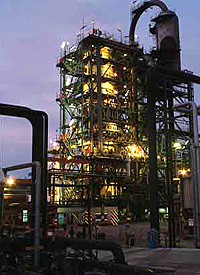“The olefin unit having nine furnaces is producing and stockpiling ethylene,” Mehrabi added.
He said 10,000 tons of the unit’s ethylene had been so far stored, out of which 7,000 tons could be exported next week.
The official said the polymer unit of Arya Sasol Petrochemical Complex would start its commercial production by next March, adding that the ethane cracking unit of the complex with an annual capacity of one million tons was undergoing pilot production process and they were expected to begin their commercial production in the upcoming February.
He said Arya Sasol Petrochemical Company was in charge of implementing the Olefin 9 project in a land with a 72 ha area in Pars Special Economic Energy Zone (PSEEZ), adding it was among the first development plans of National Petrochemical Company.
Oil Minister Gholam-Hossein Nozari said Arya Sasol Petrochemical Complex in southern
He made the statement in his meeting with the staff of Arya Sasol Petrochemical Complex.
The minister assessed as positive the growing progress of oil projects particularly in Assalouyeh, adding the capital turnover in the oil industry was not comparable with any project in the country.
Arya Sasol Petrochemical Complex (Olefin 9) has been established, with
The complex is among the world’s biggest polymer projects, whose products will be mainly exported.
When the complex comes on stream, 400 thousand tons of ethylene, 90 thousand tons of carbon 3 slice, 300 thousand tons of medium and heavy polyethylene, and 300 thousand tons of light polyethylene will be added to
Construction operations of the complex started in PSEEZ (Assalouyeh) in 2002 and the project has made over 97 progress so far.
According to the NPC, the country has exported 5.723 million tons of products during the eight-month period.
Weighing 1.65 million tons, liquefied gas had the lion’s share in the exports and methanol, ethylene, propylene, butadiene, dichloride ethylene, LAB, and PTA were the main basic chemical products exported within the period.
Propane, butane, pyrolyse, benzene, pentane plus, and heavy slice were the export-bound byproducts and fuels while benzene, paraxylene, heavy aromatic slice were the aromatic products.
Ammonia, ammonium nitrate, sulfur, and sulfuric acid are fertilizers and related products and light polyethylene, heavy polyethylene, melamine crystal, PVC, and PET are polymer products the country is planning to export.
The National Petrochemical Company (NPC) plans manager announced that 16 billion dollars would be invested in the second phase of petrochemical sector of Assalouyeh.
Jalil Ebrahimpour added the fund would be used to set up 22 petrochemical plants.
According to the NPC official, the budget is two times more than the amount invested in the first phase of Assalouyeh petrochemical sector.
The plans manager said the second phase of Assalouyeh would help the country take the second step toward the development of petrochemical industry.
Ebrahimpour added, “Out of 22 petrochemical units, the three plants of Kavian, Morvarid, and Mehr are under construction and will be expected to come on stream in mid-2008.”
He said the NPC had signed a contract with Sazeh Pardaz Consulting Company to provide utilities needed by the second phase units.
The National Petrochemical Company (NPC) Managing Director Gholamhossein Nejabat said
The NPC said domestic petrochemical output would soar to 98 million tons at the end of 10-year plan, 2014, fetching the country 20 billion dollars per annum.
“According to the plan, we have vowed to put 12 petrochemical complexes into operation in the current year (started March 21, 2007),” said the official, adding nine had already come on stream and four more would become operational by next March, the Tehran Times reported.
Nejabat said the two last petrochemical complexes of the first phase of Assalouyeh, Arya Sasol and Jam, would also start work by the yearend, March 19.
The NPC chief said 15 billion dollars had been invested in the industry since 1996, adding 12.5 billion dollars had been allotted for petrochemical projects during the Fourth Five-Year Socioeconomic Development Plan (2005-2010).
He said the figure for the Fifth Five-Year Development Plan (2010-2015) would stand at 15.3 billion dollars, adding some of the related projects had kicked off.
Shifting to foreign investments in Iranian projects, he said the country and


Your Comment